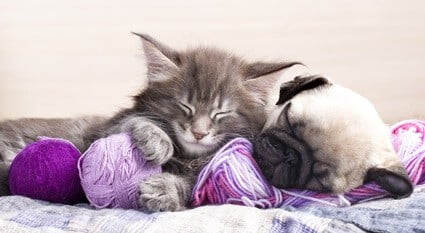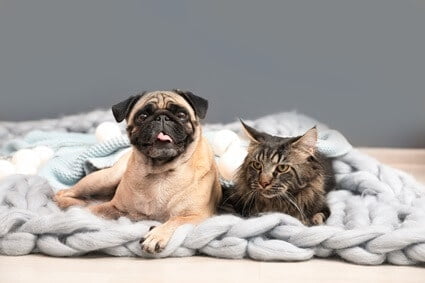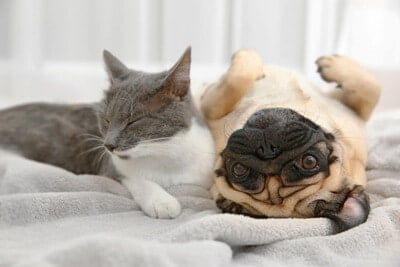If you’re looking to pair a dog and cat in the same home, you need to consider breeds carefully. A well-balanced combination can work out. Due to their small size and gentle nature, pugs are compatible with cats.
Pugs are gentle with a playful, loving temperament. As a result, a pug is unlikely to show aggression toward a cat. The opposite is likelier. If a pug is too docile, it may fall victim to a dominant cat. Equally, clingy pugs may demand more of an owner’s attention than a cat is willing to share. Ensure they’re treated equally to avoid jealousy.
So, can pugs live with cats? Pugs may be a small and friendly breed of canine, but they’re still dogs. Nobody can grow complacent when pairing housing disparate species together. Compatibility is never a certainty.
Are Pugs Cat-Friendly?
As much as cats often struggle to get along with their fellow felines, their relationship with dogs is often even more adversarial. Dogs are often larger and louder than cats, triggering your cat’s defensive instincts.
All the same, cats and dogs can make ideal housemates. You just need to consider how your resident cat will react to a canine entering its territory. If the dog is large, intimidating, and aggressive, conflict will invariably arise.
None of these are concerns with pugs. Beloved for their small, squashed faces and gentle nature, pugs are the ideal size to complement cats. A female pug is often the same size as a larger housecat, and a male is not much bigger.
Along with golden retrievers, pugs are among the gentlest breed of canine. A pug has an extremely low prey drive, meaning it is unlikely to chase or terrorize a cat. Your pug is far likelier to want to befriend its new feline housemate.
If your cat is happy to make friends and adopt a “live and let live” policy, all will likely be well. At worst, your cat will tolerate a pug and ignore it. At best, the two animals will play and sleep together, becoming firm friends.
Alas, a pug can be pretty trusting. Some might say naive. The gentle nature of these dogs may backfire if you have an abrasive cat. The pug’s attempts to make friends will be rebuffed with increasing aggression.
Equally, pugs can be prone to clinginess toward their owners. If a pug develops separation anxiety, your cat may grow equally anxious when alone. Equally, if a pug demands more of your attention than a cat considers fair, jealously – and repercussions – can arise.
Overall, pugs should be considered cat-friendly. Just do not lose sight of the fact that you are pairing a cat with a dog. Such an ambitious undertaking will always come with some degree of challenge.
Cat vs. Pug Personality
If you are looking to pair a cat with a pug, it helps to know the core personality differences between the animals. Naturally, we need to preface this with a caveat. Every cat and pug has its own personality. Equally, different cat breeds have varying traits. Overall, though, this table will give you an idea of what to expect.
| Cats | Pugs |
|---|---|
| Independent by nature and happy to be alone once a routine has been established | Often clingy and may grow increasingly anxious and destructive when left alone |
| Expect to be fed according to a schedule but can be indifferent to human food, especially sweets | Greedy pugs will eat their way through anything and everything they can get their paws on |
| Will seek out attention on occasion, but broadly only seek interaction at set times, on their terms | Will expect to be the center of attention at all times, demanding a constant array of strokes, tickles, and playtimes |
| Prefers solitude and sleeping the day away | Can be curious and playful all day, especially as a puppy |
| Will have little interest in being trained – will generally do whatever it wants | Lives to please human owners – will quickly take to training, especially when rewarded |
| Can live indoors or wander free outside, depending on established habits | Will need to be walked outside at least once a day – ideally several shorter walks |
As you’ll see, cats and pugs differ quite significantly in some ways. These disparities are not insurmountable but must be taken under advisement. As a dual pet owner, you’ll need to ensure that you meet the needs of both animals.
Can Pugs be Allergic to Cats?
Pugs are brachycephalic, meaning that they have small, squashed faces. These physical characteristics can lead to trouble breathing. As per Topics in Companion Animal Medicine, this can be life-threatening. You must take a potential allergy to cats seriously.
Allergies to cats are caused by dander – dead skin cells that fall when fur sheds. These cells are breathed in, leading to an allergic reaction. If a pug starts to wheeze and finds its airways blocked, this will be harmful sooner than in any other animal or human. Aside from trouble breathing, learn the warning signs that your pug is allergic to feline dander. These include:
- Streaming for the eyes and nose
- Coughing and sneezing (the latter of often dry)
- Breakouts of hives on the skin
- Scratching more than usual
If your pug is allergic to your cat, sadly one of your pets must move out. It’s best to look into rehoming the pug, as heartbreaking as this may be. Animal dander is stubborn. Traces can linger, even after a deep clean. This means the pug will constantly be at risk.
Of course, you’ll need to ensure that it’s the cat that is sparking this allergy before taking any urgent action. Pugs could be allergic to any number of things, including fabric softener, perfume or cologne, or even their food.
Equally, you’ll also need to be careful to ensure that your cat is not allergic to canine dander. Pugs are not hypoallergenic, shedding quite substantially for dogs of their size. Watch for any warning signs – allergy symptoms in cats are identical to those of dogs.
Can Cats and Pugs Play Together?
Cats and pugs have vastly different play styles. Cats love to stalk and hunt. Pugs, on the other hand, could not be less interested in this. Ergo, it can be challenging to play with a pug and cat simultaneously.
There are games that both animals will enjoy, though. Cats and pugs have a comparable intelligence and passion for problem-solving – especially when there is a reward at the end of the challenge. Lean into this mutual passion.
Treasure hunts are arguably the best way to encourage cats and pugs to play together. Hide a strong-smelling treat that will attract canine and feline alike in the home. Your two pets will likely work in tandem to track down the snack. Just ensure a fight does not break out upon discovery.
More than play, cats and pugs are likely to bond through mutual nap times and relaxation. Both these animals value comfort and lazy days, especially when it’s cold or wet outside. Pugs share a feline loathing for feeling cold and wet.
Provide each pet with its own bed. The territorial nature of a cat dictates that sharing will not come naturally. As cat and dog bond, though, you may find them sharing common spaces to exchange body heat.

Do Pugs Chase Cats?
Pugs have a low prey drive. These dogs are unlikely to chase a ball once they age out of puppyhood. Given that cats are of roughly equal size and move quickly, it’s doubtful that a pug will show any interest in chasing a feline.
If your pug does seem to be chasing a cat, the act will not be born of malice. Quite the opposite. The pug is likely following the cat, desperately keen to make friends and play. These attempts at bonding may be reciprocated but will likely be rejected.
For the sake of all animals in the home, give the cat a tall location to escape the pug’s attention. Pugs are not natural climbers. If your cat has territory in an elevated position, it has the chance to cool off and be alone. The pug will then seek amusement elsewhere.
Just because a pug does not chase a cat, this does not mean the behavior is mutual. As cats love to stalk, and pugs are docile, your cat may pounce on your pug from a position of hiding.
In the mind of a pug, any attention is good attention – they’ll rarely mind. Ensure your cat does not inadvertently injure the dog with such play, though. It’s easy to cross a line from recreation to accidental endangerment.
Do Pugs Bark at Cats?
Pugs can be territorial. As a result, your pug may bark at a cat, at least initially. You’ll notice this occurs more when the cat approaches you. The barking stems from a pug’s innate desire to protect its human family.
When a pug barks at a cat, it does not know if the feline is a threat. The pug thinks it is helping. If the pug barks every time the cat approaches you, though, your cat will likely grow resentful. The pug is already clingy and needs to be walked at least once a day.
These outdoor adventures will not go unnoticed by your cat, who will wonder where you and the dog are disappearing to. By getting in the way of human interaction, the pug is monopolizing your time – at the expense of the cat’s opportunities to bond.
Your pug will grow out of barking at a cat once it gets to know its feline housemate. Pug and cat alike will start to understand the other’s body language and relax in each other’s company. Work on training your pug out of needless barking as early as possible, though.
Are Cats More Territorial Than Pugs?
Cats are always more territorial than dogs in the classic sense. A pug will not look to claim a particular part of the home, for example. If a pug wanders into pre-claimed feline territory, earning a swipe for its trouble, it will wonder what happened.
Where pugs are cats will compete for territory is human attention, though. You must ensure that you make one-on-one time for your cat if you have a pug. If you’re not careful, the dog will claim every moment of your attention, leaving the cat out in the cold.
Pugs can also lack boundaries, assuming that a cat wants company at all times and is willing to share. At their heart, this is the most significant difference between cats and dogs. Felines are comparatively solitary, while canines are pack animals.
To keep your cat comfortable, and maintain harmonious relationships, separate everything in the home. Both pets should have a unique food bowl, water supply, bed, and toys.
The pug may still invade the cat’s space – and likely learn the hard way it is not welcome. Providing unique terrain and materials for both pets gives the pug somewhere to retreat to while the cat calms down, though.

Do Pugs Eat Cat Food?
Food is an area that requires care. Pugs have a reputation as greedy dogs that will eat anything in sight. Such gluttony will not just leave the pug at risk of weight gain and associated health issues. Any theft of food will also aggravate and distress your cat.
As explained by the Journal of Comparative Psychology, pugs have a superb sense of smell. In an experiment, pugs showed a superior ability to determine different scents than even a German Shepherd. Rest assured, a pug knows the difference between dog and cat food.
You could try serving cat food that your pug does not enjoy. If your cat prefers fish-based meals and your pug is indifferent, for example, this will prevent the dog from stealing food. Alas, it’s rare to find a meal that a pug will decline.
As a result, give serious consideration to feeding your cat and pug separately. Ideally, this will be at the same time but in different locations. The pug is likelier to finish eating before the cat, so be on-hand to keep your dog entertained and distracted.
You’ll also need to be careful about any free-feeding when cats and pugs share a home. You may leave feline kibble out for a cat to eat overnight, for example. Once spotted, a pug will gleefully gorge itself on this, treating the kibble as a buffet.
Eating cat food is unlikely to make your pug sick. In a pinch, cats can eat dog food and vice versa. Be mindful of your pug gorging itself to excess, though. In addition, remember that having its food stolen will understandably aggravate a territorial cat.
Introducing Pugs to Cats
The best age to introduce cats to pugs is as young as possible. Applied Animal Behavior Science confirms that early exposure enhances the chances of the animals developing a bond. Puppies and kittens share similar energy levels and open-minded curiosity.
If you are adopting both pets at a young age, try to bring the pug home first. A dog will accept a cat into its space far more willingly than vice versa. If you are introducing a pug to an established cat, this is not an option.
In this instance, do not rush the introductions. Keep your cat out of the way in the claimed territory while the pug explores its new home. If your pets interact immediately, the cat is likely to hiss and swipe at the pug.
The best way to introduce your pug and cat slowly and steadily is through a dinner date. Serve both pets a meal, albeit separated by a barrier. The important thing is that the dog and cat can smell and see each other while eating. This creates a positive association.
Eventually, you’ll need to let the two pets interact directly. Do not leave them unsupervised. Consider keeping the pug on its leash, allowing the cat to approach when it builds up sufficient courage.
Do not expect an immediate bond. If the cat ignores your pug, consider that a minor victory. Offer both animals a suitable treat to celebrate the lack of conflict. Over a prolonged period, apathy can transition into friendship.
Of all dog breeds, pugs are arguably the most compatible with cats. Get the introductions right, and you may find that your cat and pug become friends for life. As with all dog and cat combinations, the reverse can also be true. Take your time to pair the ideal pug with your cat.

